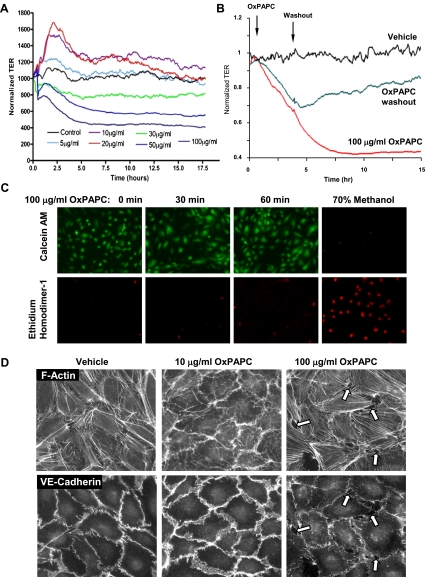Figure 1.
Dose-dependent effects of oxidized 1-palmitoyl-2-arachidonyl-sn-glycero-3-phosphocholine (OxPAPC) on transendothelial electrical resistance (TER) and endothelial monolayer integrity. (A) Human pulmonary artery endothelial cells (HPAECs) were seeded in polycarbonate wells with gold microelectrodes. After 24 hours of culture, HPAECs were stimulated with various OxPAPC concentrations (5, 10, 20, 30, 50, and 100 μg/ml) or vehicle, and measurements of TER were monitored for 18 hours, using an electrical cell-substrate impedance sensing system. The results are representative of five independent experiments. (B) After exposure to 100 μg/ml OxPAPC and TER measurements, the culture medium was replaced by a fresh serum-free medium without OxPAPC, and TER changes in endothelial cell (EC) monolayers grown on microelectrodes were monitored over an additional period of time. The removal of OxPAPC from the culture medium partly restored TER in HPAEC monolayers. (C) Effects of 100 μg/ml OxPAPC on HPAEC viability. Cells were subjected to 100 μg/ml OxPAPC for 4 hours, and cell viability was assessed as described in Materials and Methods. Methanol treatment was used as a positive control for cell death. (D) Endothelial monolayers grown on glass coverslips were stimulated with OxPAPC (10 μg/ml or 100 μg/ml) for 30 minutes, followed by double immunofluorescence staining for F-actin or vascular endothelial cadherin (VE-cadherin). Arrows indicate areas of intercellular gaps caused by treatment with 100 μg/ml OxPAPC. The results shown are representative of three independent experiments. AM, acetoxymethyl.

